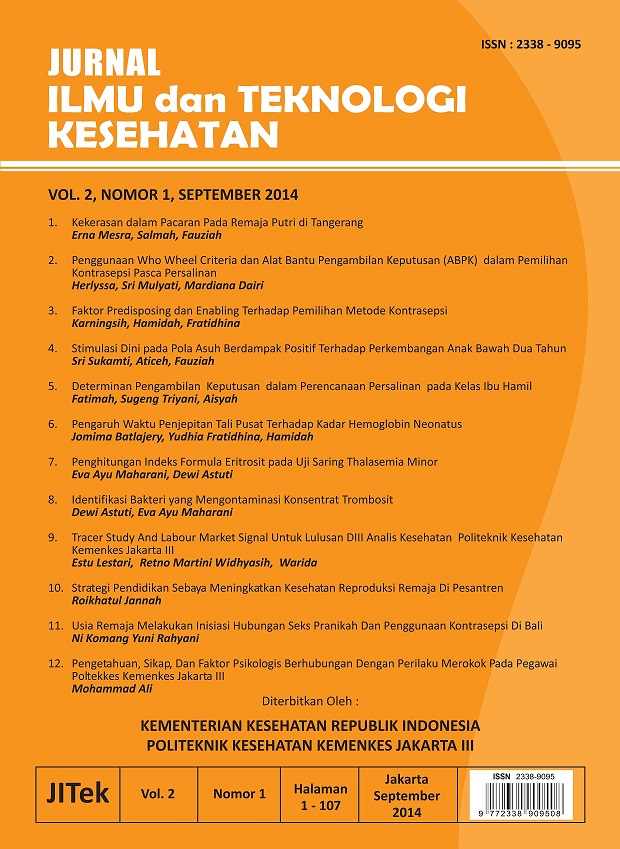Main Article Content
Abstract
Adolescent were sexually active, will facing the negative impact in their health in the future. The study aim is to analyze the time of premarital sexual intercourse initiation and contraception use among adolescent age 15 - 18 years old in Bali. The study design was a longitudinal study with observations over 16 months. The study population was students in two high school grade 10 and 11 in the city of Denpasar. Samples were 169 respondents included in this study. Statistical analysis used the Kaplan-Meier life table to determine the premarital sexual intercourse initiation probability by age. Results: Of the 169 adolescent samples classified as not at risk (48 males and 129 females), the incidence of premarital sexual intercourse initiation in male and female was 14.6% and 6.6%, respectively. Kaplan-Meier life table analysis show that the risk of adolescent male of losing their virginity until the age of 18.5 was four times higher than female (58.5% vs. 14.2%). Contraception use were lower among female adolescent than male adolescent (37.5% vs 42.9%), and adolescent who were lived in urban area than rural area (38,5% vs 50,0%). Conclusion: Contraception use among female adolescent was lower than male adolescent. We need to improve adolescent knowledge about contraception and consideration about contraception service among adolescent who were sexually active.
Keywords
Article Details
Authors who publish with this journal agree to the following terms:
1. Authors retain copyright and grant the journal right of first publication with the work simultaneously licensed under a Creative Commons Attribution-ShareAlike License that allows others to share the work with an acknowledgment of the work's authorship and initial publication in this journal.
2. Authors are able to enter into separate, additional contractual arrangements for the non-exclusive distribution of the journal's published version of the work (e.g., post it to an institutional repository or publish it in a book), with an acknowledgment of its initial publication in this journal.
3. Authors are permitted and encouraged to post their work online (e.g., in institutional repositories or on their website) prior to and during the submission process, as it can lead to productive exchanges, as well as earlier and greater citation of published work (See The Effect of Open Access).
References
-
Adolescent., C.O. 1999. Adolescent pregnancy-current trends and issues. American Academy of Pediatrics, 103 (2)516-520.
Alan Guttmacher Institute (AGI). 1994. Sex and America's Teenagers. New York: Alan Guttmacher Institute.
American Academy of Pediatrics. 1999. Contraception and Adolescents. Pediatrics, 104(5): 1161-1166.
Badan Kependudukan dan Keluarga Berencana Nasional, Badan Pusat Statistik, Kementerian Kesehatan. 2013. MEASURE DHS & International, I. Indonesia Demographic and Health Survey 2012, Jakarta, Indonesia:BPS, BKKBN, Kemenkes, and ICF International.
Blanc, A. K. & Way, A. A. (1998) Sexual behavior and contraceptive knowledge and use among adolescents in developing countries. Studies Fam Plan, 29(2): 106- 116.
Bruce, J. 1990. Fundamental elements of quality of care: a simple framework. Studies in Family Planning, 2161-91.
Farmer, M. A., Trapnell, P. D. & Meston, C. M. 2009. The relation between sexual behavior and religiosity subtypes: a test of the secularization hypothesis. Arch Sex Behav, 38(5): 852-65.
Gillmore, M. R., Archibald, M. E., Morrison, D. M., Wilsdon, A., Wells, E. A., Hoppe, M. J., Nahom, D. & Murowchick, E. 2002. Teen sexual behavior: Applicability of the theory of reasoned action. Journal of Marriage and Family, 64: 885-897.
Greenberg, J., Magder, L. & Aral, S.(1992. Age at first coitus: A marker for risky sexual behavior in women. Sexually Transmitted Diseases, 19(6): 331-334.
Hull, T. H., Hasmi, E. & Widyantoro, N. 2004. "Peer" educator initiatives for adolescent reproductive health projects in Indonesia. Reproductive Health Matters, 12 (23)29- 39.
Hutchinson, K. A. 1995. Androgens and sexuality. Am J Med, 98(1A): 111S-115S.
Igra, V. & Millstein, S. 1993. Current status and approaches to improving preventive services for adolescents. Journal of the American Medical Association, 2691408- 1412.
Irwin, C. E. & Millstein, S. G. 1986. Biopsychosocial correlates of risk taking behaviors during adolescence: Can the physician intervene? Journal of Adolescent Health Care, 7 (6 supplement): 82-96.
